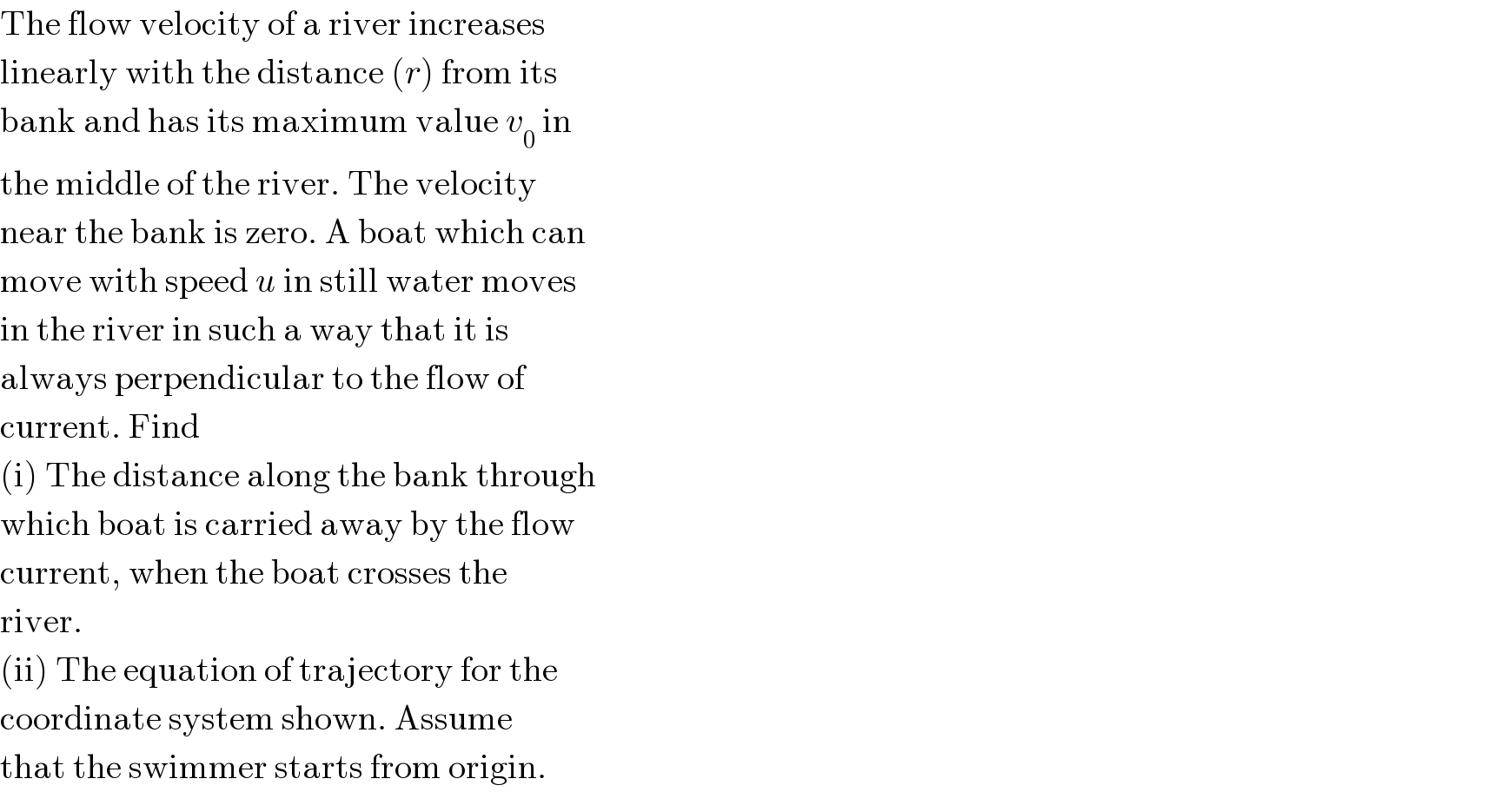
Question Number 18269 by Tinkutara last updated on 17/Jul/17

$$\mathrm{The}\:\mathrm{flow}\:\mathrm{velocity}\:\mathrm{of}\:\mathrm{a}\:\mathrm{river}\:\mathrm{increases} \\ $$$$\mathrm{linearly}\:\mathrm{with}\:\mathrm{the}\:\mathrm{distance}\:\left({r}\right)\:\mathrm{from}\:\mathrm{its} \\ $$$$\mathrm{bank}\:\mathrm{and}\:\mathrm{has}\:\mathrm{its}\:\mathrm{maximum}\:\mathrm{value}\:{v}_{\mathrm{0}} \:\mathrm{in} \\ $$$$\mathrm{the}\:\mathrm{middle}\:\mathrm{of}\:\mathrm{the}\:\mathrm{river}.\:\mathrm{The}\:\mathrm{velocity} \\ $$$$\mathrm{near}\:\mathrm{the}\:\mathrm{bank}\:\mathrm{is}\:\mathrm{zero}.\:\mathrm{A}\:\mathrm{boat}\:\mathrm{which}\:\mathrm{can} \\ $$$$\mathrm{move}\:\mathrm{with}\:\mathrm{speed}\:{u}\:\mathrm{in}\:\mathrm{still}\:\mathrm{water}\:\mathrm{moves} \\ $$$$\mathrm{in}\:\mathrm{the}\:\mathrm{river}\:\mathrm{in}\:\mathrm{such}\:\mathrm{a}\:\mathrm{way}\:\mathrm{that}\:\mathrm{it}\:\mathrm{is} \\ $$$$\mathrm{always}\:\mathrm{perpendicular}\:\mathrm{to}\:\mathrm{the}\:\mathrm{flow}\:\mathrm{of} \\ $$$$\mathrm{current}.\:\mathrm{Find} \\ $$$$\left(\mathrm{i}\right)\:\mathrm{The}\:\mathrm{distance}\:\mathrm{along}\:\mathrm{the}\:\mathrm{bank}\:\mathrm{through} \\ $$$$\mathrm{which}\:\mathrm{boat}\:\mathrm{is}\:\mathrm{carried}\:\mathrm{away}\:\mathrm{by}\:\mathrm{the}\:\mathrm{flow} \\ $$$$\mathrm{current},\:\mathrm{when}\:\mathrm{the}\:\mathrm{boat}\:\mathrm{crosses}\:\mathrm{the} \\ $$$$\mathrm{river}. \\ $$$$\left(\mathrm{ii}\right)\:\mathrm{The}\:\mathrm{equation}\:\mathrm{of}\:\mathrm{trajectory}\:\mathrm{for}\:\mathrm{the} \\ $$$$\mathrm{coordinate}\:\mathrm{system}\:\mathrm{shown}.\:\mathrm{Assume} \\ $$$$\mathrm{that}\:\mathrm{the}\:\mathrm{swimmer}\:\mathrm{starts}\:\mathrm{from}\:\mathrm{origin}. \\ $$
Commented by Tinkutara last updated on 17/Jul/17

Commented by mrW1 last updated on 19/Jul/17
![u_y =u y=ut u_x =((2y)/d)v_0 =((2v_0 )/d)y with 0≤y≤(d/2) u_x =((2(d−y))/d)v_0 =2v_0 (1−(y/d)) with (d/2)≤y≤d u_x =(dx/dt)=(dx/dy)×(dy/dt)=u(dx/dy) ⇒u(dx/dy)=((2v_0 )/d)y with 0≤y≤(d/2) ⇒u(dx/dy)=2v_0 (1−(y/d)) with (d/2)≤y≤d x=(v_0 /(ud))y^2 +C_1 C_1 =0 since x=0 at y=0 ⇒x=(v_0 /du)y^2 with 0≤y≤(d/2) at y=(d/2): x=((v_0 d)/(4u)) x=((2v_0 )/u)(y−(y^2 /(2d)))+C_2 at y=(d/2): ((v_0 d)/(4u))=((2v_0 )/u)[(d/2)−(d/8)]+C_2 C_2 =−((v_0 d)/(2u)) ⇒x=((2v_0 )/u)(y−(y^2 /(2d))−(d/4)) with (d/2)≤y≤d at y=d: x=((v_0 d)/(2u)) y=ut x=((v_0 u)/d)t^2 with 0≤t≤(d/(2u)) x=2v_0 (t−((ut^2 )/(2d))−(d/(4u))) with (d/(2u))≤t≤(d/u)](Q18352.png)
$$\mathrm{u}_{\mathrm{y}} =\mathrm{u} \\ $$$$\mathrm{y}=\mathrm{ut} \\ $$$$\mathrm{u}_{\mathrm{x}} =\frac{\mathrm{2y}}{\mathrm{d}}\mathrm{v}_{\mathrm{0}} =\frac{\mathrm{2v}_{\mathrm{0}} }{\mathrm{d}}\mathrm{y}\:\mathrm{with}\:\mathrm{0}\leqslant\mathrm{y}\leqslant\frac{\mathrm{d}}{\mathrm{2}} \\ $$$$\mathrm{u}_{\mathrm{x}} =\frac{\mathrm{2}\left(\mathrm{d}−\mathrm{y}\right)}{\mathrm{d}}\mathrm{v}_{\mathrm{0}} =\mathrm{2v}_{\mathrm{0}} \left(\mathrm{1}−\frac{\mathrm{y}}{\mathrm{d}}\right)\:\mathrm{with}\:\frac{\mathrm{d}}{\mathrm{2}}\leqslant\mathrm{y}\leqslant\mathrm{d} \\ $$$$ \\ $$$$\mathrm{u}_{\mathrm{x}} =\frac{\mathrm{dx}}{\mathrm{dt}}=\frac{\mathrm{dx}}{\mathrm{dy}}×\frac{\mathrm{dy}}{\mathrm{dt}}=\mathrm{u}\frac{\mathrm{dx}}{\mathrm{dy}} \\ $$$$\Rightarrow\mathrm{u}\frac{\mathrm{dx}}{\mathrm{dy}}=\frac{\mathrm{2v}_{\mathrm{0}} }{\mathrm{d}}\mathrm{y}\:\mathrm{with}\:\mathrm{0}\leqslant\mathrm{y}\leqslant\frac{\mathrm{d}}{\mathrm{2}} \\ $$$$\Rightarrow\mathrm{u}\frac{\mathrm{dx}}{\mathrm{dy}}=\mathrm{2v}_{\mathrm{0}} \left(\mathrm{1}−\frac{\mathrm{y}}{\mathrm{d}}\right)\:\mathrm{with}\:\frac{\mathrm{d}}{\mathrm{2}}\leqslant\mathrm{y}\leqslant\mathrm{d} \\ $$$$\mathrm{x}=\frac{\mathrm{v}_{\mathrm{0}} }{\mathrm{ud}}\mathrm{y}^{\mathrm{2}} +\mathrm{C}_{\mathrm{1}} \\ $$$$\mathrm{C}_{\mathrm{1}} =\mathrm{0}\:\mathrm{since}\:\mathrm{x}=\mathrm{0}\:\mathrm{at}\:\mathrm{y}=\mathrm{0} \\ $$$$\Rightarrow\mathrm{x}=\frac{\mathrm{v}_{\mathrm{0}} }{\mathrm{du}}\mathrm{y}^{\mathrm{2}} \:\mathrm{with}\:\mathrm{0}\leqslant\mathrm{y}\leqslant\frac{\mathrm{d}}{\mathrm{2}} \\ $$$$\mathrm{at}\:\mathrm{y}=\frac{\mathrm{d}}{\mathrm{2}}:\:\mathrm{x}=\frac{\mathrm{v}_{\mathrm{0}} \mathrm{d}}{\mathrm{4u}} \\ $$$$ \\ $$$$\mathrm{x}=\frac{\mathrm{2v}_{\mathrm{0}} }{\mathrm{u}}\left(\mathrm{y}−\frac{\mathrm{y}^{\mathrm{2}} }{\mathrm{2d}}\right)+\mathrm{C}_{\mathrm{2}} \\ $$$$\mathrm{at}\:\mathrm{y}=\frac{\mathrm{d}}{\mathrm{2}}: \\ $$$$\frac{\mathrm{v}_{\mathrm{0}} \mathrm{d}}{\mathrm{4u}}=\frac{\mathrm{2v}_{\mathrm{0}} }{\mathrm{u}}\left[\frac{\mathrm{d}}{\mathrm{2}}−\frac{\mathrm{d}}{\mathrm{8}}\right]+\mathrm{C}_{\mathrm{2}} \\ $$$$\mathrm{C}_{\mathrm{2}} =−\frac{\mathrm{v}_{\mathrm{0}} \mathrm{d}}{\mathrm{2u}} \\ $$$$\Rightarrow\mathrm{x}=\frac{\mathrm{2v}_{\mathrm{0}} }{\mathrm{u}}\left(\mathrm{y}−\frac{\mathrm{y}^{\mathrm{2}} }{\mathrm{2d}}−\frac{\mathrm{d}}{\mathrm{4}}\right)\:\mathrm{with}\:\frac{\mathrm{d}}{\mathrm{2}}\leqslant\mathrm{y}\leqslant\mathrm{d} \\ $$$$\mathrm{at}\:\mathrm{y}=\mathrm{d}:\:\mathrm{x}=\frac{\mathrm{v}_{\mathrm{0}} \mathrm{d}}{\mathrm{2u}} \\ $$$$ \\ $$$$\mathrm{y}=\mathrm{ut} \\ $$$$\mathrm{x}=\frac{\mathrm{v}_{\mathrm{0}} \mathrm{u}}{\mathrm{d}}\mathrm{t}^{\mathrm{2}} \:\mathrm{with}\:\mathrm{0}\leqslant\mathrm{t}\leqslant\frac{\mathrm{d}}{\mathrm{2u}} \\ $$$$\mathrm{x}=\mathrm{2v}_{\mathrm{0}} \left(\mathrm{t}−\frac{\mathrm{ut}^{\mathrm{2}} }{\mathrm{2d}}−\frac{\mathrm{d}}{\mathrm{4u}}\right)\:\mathrm{with}\:\frac{\mathrm{d}}{\mathrm{2u}}\leqslant\mathrm{t}\leqslant\frac{\mathrm{d}}{\mathrm{u}} \\ $$
Commented by mrW1 last updated on 19/Jul/17

